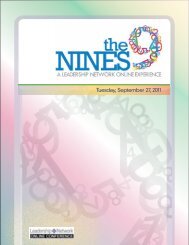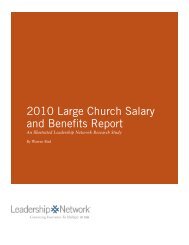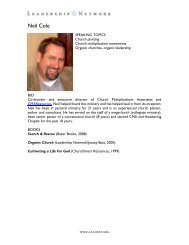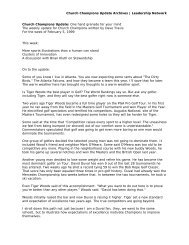ARE WE A PEOPLE AT HALF TIME? - Leadership Network
ARE WE A PEOPLE AT HALF TIME? - Leadership Network
ARE WE A PEOPLE AT HALF TIME? - Leadership Network
You also want an ePaper? Increase the reach of your titles
YUMPU automatically turns print PDFs into web optimized ePapers that Google loves.
Having a mid-life crisis on purpose<br />
Richard Leider and David<br />
Shapiro use the metaphor of unpacking<br />
and repacking one’s bag in their<br />
new book, Repacking Your Bags, in<br />
which they encourage people to have<br />
a mid-life crisis on purpose. “To<br />
have a purposeful mid-life crisis, we<br />
must turn our gaze inward and examine<br />
where we are, where we want to<br />
go, and how we want to get there.<br />
We need to consider all that we are<br />
carrying on our journey to determine<br />
if it is really what we need for the<br />
road ahead. To put it simply, we<br />
must unpack and repack our bags.” 3<br />
“Unpacking simply<br />
means taking a long hard<br />
look at what we are carrying<br />
and why. It is seeing if our<br />
4.5<br />
possessions, responsibilities<br />
and relationships are still 4.0<br />
helping us move forward<br />
3.5<br />
or if they are dragging us<br />
down. Repacking then, is the<br />
3.0<br />
ongoing activity of reevaluation<br />
and reinvention.” 4<br />
2.5<br />
POPUL<strong>AT</strong>ION IN MILLIONS<br />
The forces driving half time 2.0<br />
There are many forces 1.5<br />
driving half time in the U.S.<br />
1.0<br />
Three of the most important<br />
ones are the demography of<br />
0.5<br />
the population, the shift<br />
from the industrial worker to 0<br />
the knowledge worker, and<br />
the impact of technology.<br />
The most obvious is demography<br />
as 74.7 million people,<br />
or almost one of every three<br />
adults in the population, are within<br />
the ideal mid-life age zone of 35-55.<br />
The majority of those in “the zone”<br />
right now are part of the Boomer<br />
generation and the remainder are the<br />
younger members of the Silent generation.<br />
We are at the front end of a<br />
tidal wave of normal mid-life transition<br />
in which millions of people are<br />
evaluating not only their lives to this<br />
point but the “second half” or the<br />
rest of their life.<br />
A second force is the historical<br />
shift from the industrial age to the<br />
information age. The result has been<br />
a new type of worker, the knowledge<br />
worker, who is valued not for what<br />
can be manufactured but for the<br />
creation, transfer, and application of<br />
information and services. The peak<br />
“burn out” years for the knowledge<br />
worker are 35-45 and unlike their<br />
predecessors in the work force whose<br />
physical bodies were exhausted from<br />
manufacturing and production, it is<br />
the mind, emotion, and spirit of the<br />
knowledge worker that withers.<br />
Despite their apparent success, they<br />
are becoming weary, dispirited and<br />
THE COMING TRANSITIONAL TIDAL WAVE<br />
55 54 53 52 51 50 49 48 47 46 45 44 43 42 41 40 39 38 37 36 35<br />
© 1995 <strong>Leadership</strong> <strong>Network</strong>, all rights reserved.<br />
Total: 74.7 million in “the zone”<br />
1995 AGES<br />
bored with their lives and their work.<br />
“On the whole, we are a society<br />
of notoriously numb people – lonely,<br />
bored, dependent people who are<br />
happy only when we have killed the<br />
time we are trying hard to save. We<br />
worry constantly about making a living<br />
but rarely about making a life.” 5<br />
To quote one participant in a recent<br />
workshop on creating the second half<br />
of one’s life, “I finally got it – there is<br />
a difference between success and<br />
fulfillment. I had success, but I<br />
wasn’t fulfilled. Maybe success is<br />
getting what you want. Fulfillment,<br />
though, is wanting what you get.” 6<br />
The third driver of half time is<br />
technology and the resulting pressures<br />
that it produces in terms of discontinuity<br />
and change. Despite new tools that<br />
are designed to save time, people feel<br />
more harried than ever as the pace of<br />
change continues to accelerate. “Is it<br />
possible that we are in a period of<br />
history when change has come so<br />
fast that is has dangerously outpaced<br />
the human psyche (or soul)” was<br />
the question posed recently to a<br />
group of senior level corporate<br />
managers. “Perhaps you are on the<br />
back of a beautiful horse called<br />
technology which is<br />
racing headlong toward<br />
something that looks like<br />
the edge of a cliff. And<br />
rather than contemplate the<br />
possibility of going over it<br />
in your private lives, you<br />
take the edge off your anxiety<br />
by talking about how<br />
wonderfully fast the horse<br />
(technology) is.”<br />
The need for “soul care”<br />
We live in a day and<br />
age where a great many<br />
people are spending their<br />
time examining the mind<br />
and the human capacity to<br />
innovate and organize yet<br />
we have forgotten our<br />
souls. As a society, we are<br />
only beginning to understand<br />
the price we have paid in our<br />
quest for individualism and the<br />
accumulation of goods and capital,<br />
both personally and corporately. The<br />
internal has been sacrificed to the<br />
external.<br />
The word used by many to<br />
describe their core, that place deep<br />
inside where they really live, despite<br />
all the external trappings, is “empty.”<br />
Gordon MacDonald has called this<br />
area “the soul below the waterline,”<br />
and notes “how important it is to<br />
consult the soul while we live in a<br />
2







